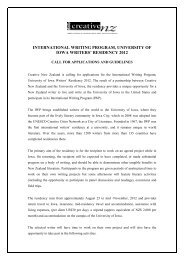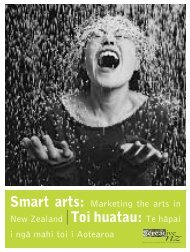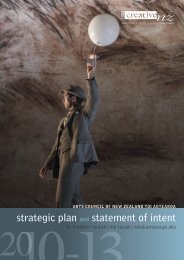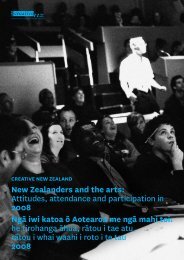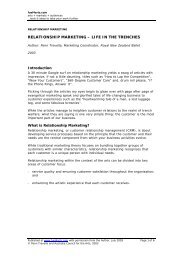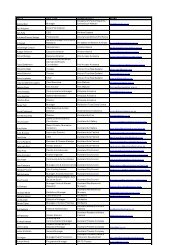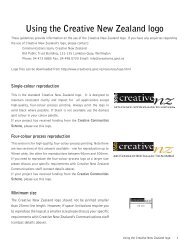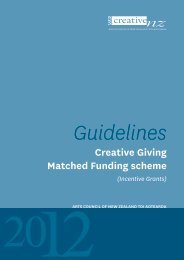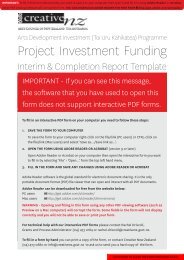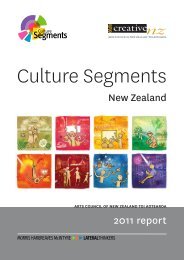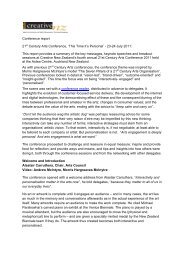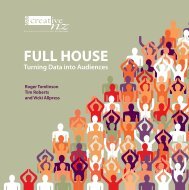CASE STUDY – CREATIVE TOURISM NEW ZEALAND
CASE STUDY – CREATIVE TOURISM NEW ZEALAND
CASE STUDY – CREATIVE TOURISM NEW ZEALAND
You also want an ePaper? Increase the reach of your titles
YUMPU automatically turns print PDFs into web optimized ePapers that Google loves.
fuel4arts.com<br />
arts + markets + audiences<br />
…tools & ideas to take your work further<br />
CULTURAL RE<strong>NEW</strong>AL + <strong>TOURISM</strong><br />
<strong>CASE</strong> <strong>STUDY</strong> <strong>–</strong> <strong>CREATIVE</strong> <strong>TOURISM</strong> <strong>NEW</strong> <strong>ZEALAND</strong><br />
Author: Crispin Raymond, Creative Tourism New Zealand<br />
Background<br />
Most of the boom in tourism in the last 50 years has been in sun-sea-sand<br />
holidays. However, while these are certain to remain a major part of tourism in<br />
the future, as a proportion of the total international tourist market they have<br />
already begun to fall.<br />
This is happening for a number of reasons. The growth of additional and shortbreak<br />
holidays means that tourists have the opportunity and the inclination to do<br />
something different for their ‘extra’ holidays.<br />
The aging and better-educated population of many countries has created a<br />
demand for a different sort of holiday. Health fears mean that even with the<br />
strongest sun creams fewer people want to toast all day on the beach. Of the<br />
alternative types of tourism, cultural tourism is becoming the most popular.<br />
Cultural tourists visit other countries to learn about their culture. However, this<br />
learning process is generally fairly passive: walking round museums and galleries,<br />
visiting historic buildings and monuments, attending artistic and cultural events.<br />
Most of the experiences they sample do not encourage them to express<br />
themselves. They are more likely to be observers than participants.<br />
New Directions<br />
Creative Tourism is a logical development of cultural tourism and goes a step<br />
further. Creative tourists are not just passive consumers but become more<br />
actively involved in the culture of the countries and communities they are visiting.<br />
While the cultural tourist enjoys visiting, say, a pottery studio or sampling a<br />
range of local foods, the creative tourist takes part in a pottery course or learns<br />
to cook local dishes.<br />
The creative tourist is a participant, someone who learns by doing, someone who<br />
finds enjoyment and fulfilment in developing new abilities. As a result, creative<br />
tourists get closer to the cultures and the people of the countries they visit. In the<br />
words of the Chinese proverb: ‘I hear and I forget, I see and I remember, I do<br />
and I understand’.<br />
Published at www.fuel4arts.com with permission from the Author, September 2003 Page 1 of 5<br />
© Creative Tourism New Zealand and Australia Council for the Arts, 2003
fuel4arts.com<br />
arts + markets + audiences<br />
…tools & ideas to take your work further<br />
Where does the concept of 'Creative Tourism' come from?<br />
3 years ago I attended a lecture by Greg Richards, an authority on cultural<br />
tourism, and the author of a number of books and articles on the subject. He<br />
argued that cultural tourism, even as demand grew, risked causing dissatisfaction<br />
because of its failure to engage. It needed to become more creative, he said.<br />
A metaphorical light flashed: Creative Tourism, great expression, I thought. We<br />
got together after the lecture and decided to try to develop the concept, Greg in<br />
academic circles, me in New Zealand, the country to which I was about to<br />
migrate.<br />
Creative Tourism in New Zealand<br />
So, having subsequently settled in the Nelson/Tasman region at the top of New<br />
Zealand's South Island, how could I put the Creative Tourism idea into practice?<br />
Following initial discussions with the Regional Tourist Office I met Nelson Bays<br />
Arts Marketing Network (NBAM), the region's well-respected arts marketing<br />
agency. Ali Boswijk, its Chief Executive, was attracted by the possibility of<br />
Creative Tourism providing a new income stream for local artists. She had some<br />
public funding available for cluster development and agreed to incubate the<br />
project for a 'pilot period' so that the key features of supply and demand could be<br />
better understood.<br />
We held an inaugural meeting last December to discuss the possibility of forming<br />
a network amongst local artists to offer workshops. World of WearableArt and The<br />
Suter te Aratoi o Whakatu, two of Nelson's flagship arts organisations, together<br />
with a number of other established organisations and interested individuals,<br />
agreed to become members. An embryonic organisation, Creative Tourism New<br />
Zealand (CTNZ), emerged and was launched on 1 May 2003 by Dame Cheryll<br />
Sotheran, the founder of Wellington's Te Papa museum.<br />
CTNZ now has 23 Members offering a range of workshops and learning<br />
experiences that reflect the diverse culture of this part of New Zealand: from<br />
harakeke (flax) weaving to woolcraft, from bone carving to bronze casting, from<br />
ceramics to native plant propagation, from seafood cookery to wood working.<br />
Workshops last from 2 hours to 4 days. Some include meals, most ask<br />
participants to bring their own sandwiches. Costs range from $55 to $650. All the<br />
workshops are small, with a maximum of twelve participants and usually less.<br />
Workshops can be booked directly with Members or through the local Visitor<br />
Information Office in Motueka. The latter is providing this booking service for free<br />
during the pilot period partly because they hope to sell other services to potential<br />
creative tourists but mainly because they see the long-term potential of an<br />
additional aspect of tourism for region.<br />
CTNZ Members meet bi-monthly to discuss progress. These meetings bring<br />
together artists and crafts people and help the bonds between them.<br />
Each Member has been asked to recommend accommodation nearby, places<br />
where they feel that participants on their workshops will enjoy staying. This has<br />
involved a further 30 plus people who want to see CTNZ succeed.<br />
Published at www.fuel4arts.com with permission from the Author, September 2003 Page 2 of 5<br />
© Creative Tourism New Zealand and Australia Council for the Arts, 2003
fuel4arts.com<br />
arts + markets + audiences<br />
…tools & ideas to take your work further<br />
NBAM's role was, and still is, invaluable. At the start, when Creative Tourism was<br />
just an idea, they contributed credibility and contacts to potential Members. They<br />
continue to provide marketing contacts and support. But they also provide an<br />
existing organisational framework as decisions about an appropriate long-term<br />
legal structure for CTNZ have not yet had to be made.<br />
Segmentation - Who Are Creative Tourists?<br />
Are tourists flocking to attend? Not yet, but the signs are encouraging and the<br />
New Zealand summer, when we expect most participants, lies ahead. We have<br />
already established that marketing a mix of workshops under the Creative<br />
Tourism ‘brand’, attracts more interest than most individuals can achieve by<br />
themselves.<br />
We also think that Creative Tourism will appeal to three groups.<br />
The first group of potential creative tourists are the baby-boomers and newly<br />
retired. Having achieved a level of material comfort, often at a price of focusing<br />
predominantly on work, they are frequently looking for intellectual stimulus and<br />
fresh opportunities to find out about things which have always interested them<br />
but which they have never got round to doing.<br />
The second group are the under 30s, often students, backpackers, perhaps<br />
visiting New Zealand on a ‘gap year’. Creative Tourism appeals to those with open<br />
minds who are still finding their way in life particularly after they have survived a<br />
range of physical travel adventures and are starting to look for experiences that<br />
stretch the mind as well as the body!<br />
And, thirdly, New Zealanders themselves of all ages are interested to learn more<br />
about different aspects of their country’s culture.<br />
Encouragingly, Tourism New Zealand recently completed market research which<br />
has led to a profile of the ideal visitor to New Zealand: the 'Interactive Traveller'<br />
http://www.tourisminfo.govt.nz/cir_rand. This person wants to interact with local<br />
Kiwis and learn more about local culture in small groups though participatory<br />
learning experiences. In many ways, the Interactive Traveller is a creative tourist!<br />
Marketing<br />
The core tool of our marketing approach is the website<br />
www.creativetourism.co.nz which is updated bi-monthly in the light of<br />
experience. This provides details of workshops and their tutors. It also contains<br />
valuable endorsements from organisations and people such as Maureen Wheeler,<br />
co-founder of Lonely Planet. These again add credibility.<br />
However, since there are now supposed to be almost as many websites as there<br />
are people on the planet, getting the site noticed by our potential market is the<br />
real challenge.<br />
We approach this through a variety of means, including:<br />
- encouraging our members and accommodation providers to spread the word to<br />
those they know;<br />
- reciprocal links to others whose markets overlap ours. The most referrals at<br />
the moment are coming from the Lonely Planet website;<br />
Published at www.fuel4arts.com with permission from the Author, September 2003 Page 3 of 5<br />
© Creative Tourism New Zealand and Australia Council for the Arts, 2003
fuel4arts.com<br />
arts + markets + audiences<br />
…tools & ideas to take your work further<br />
- links from tourist organisations promoting New Zealand and Nelson. For<br />
example see the home page of Latitude Nelson's website:<br />
http://www.nelsonnz.com/ or look at the bottom of 'A Creative View of New<br />
Zealand' on New Zealand's national tourism website:<br />
http://www.purenz.com/index.cfm/purenz_page/E0AFB440-5D94-4B98-910F-<br />
8B36A11391B3.html.<br />
- rack cards in local visitor information offices;<br />
- pursuing journalists; and<br />
- contacting universities and colleges that teach tourism.<br />
Is this enough? No, it is only a very modest start. The main constraint is money.<br />
Budget<br />
By piloting CTNZ within NBAM it has been possible to attract some grants and<br />
sponsorship. Industry New Zealand, the Community Trust and Nelson<br />
Marlborough Institute of Technology have all contributed.<br />
These funds, together with subscriptions from Members and recommended<br />
accommodation providers are now approaching NZ$20,000. They have covered<br />
the costs of the website development and maintenance, initial print and NBAM's<br />
staff time.<br />
However, no paid advertising can yet be afforded and I am leading the project on<br />
a voluntary basis for the time being.<br />
And then What?<br />
The pilot period will run until Easter 2004. If all has gone well and sufficient<br />
creative tourists have participated in our Members' workshops for us to be<br />
confident of developing a sustainable organisation, CTNZ will build on what it has<br />
learnt and expand to offer workshops throughout the country.<br />
A decision will then be made about the most appropriate legal structure for the<br />
organisation: the options are staying within NBAM, becoming a separate not-forprofit<br />
or becoming a commercial business.<br />
If all continues to go well, then it could eventually be exciting to help set up<br />
Creative Tourism networks in other countries and share what has been learnt in<br />
New Zealand. Every country and region has skills and traditions that are of<br />
potential interest to the creative tourist. The list of possible experiences is as long<br />
as the list of abilities that mankind has developed in the different environments in<br />
which he lives.<br />
Creative Tourism has enormous potential but the speed with which this can be<br />
realised is still uncertain. The possibility, however, that New Zealand could one<br />
day be known as the home of Creative Tourism in the same way as it is<br />
recognised as a primary destination for Adventure Tourism is a stimulating one.<br />
Published at www.fuel4arts.com with permission from the Author, September 2003 Page 4 of 5<br />
© Creative Tourism New Zealand and Australia Council for the Arts, 2003
fuel4arts.com<br />
arts + markets + audiences<br />
…tools & ideas to take your work further<br />
The demand for cultural tourism seems sure to continue to grow and for countries<br />
like New Zealand that have less historic buildings and cultural infrastructure than<br />
Europe, Creative Tourism offers a more imaginative and lower cost way to help<br />
meet the cultural expectations of its visitors.<br />
Further reading<br />
CTNZ website's FAQs provides a list of Greg's articles and books on Creative<br />
Tourism. See the answer to the fifth question on:<br />
http://www.creativetourism.co.nz/faqs.htm.<br />
Published at www.fuel4arts.com with permission from the Author, September 2003 Page 5 of 5<br />
© Creative Tourism New Zealand and Australia Council for the Arts, 2003



